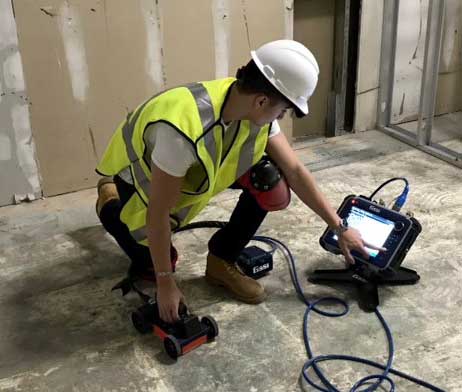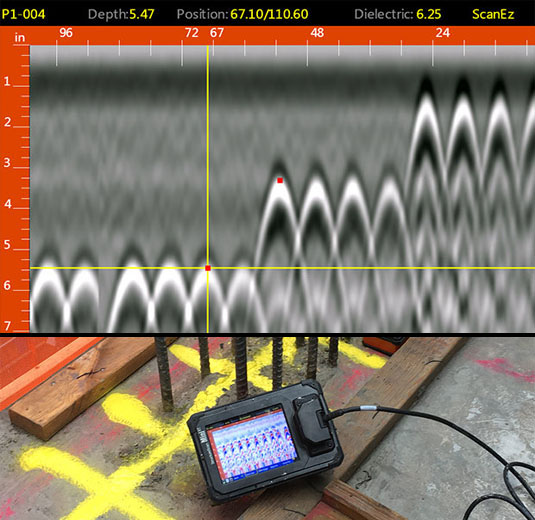Introduce the Transformative Power of Concrete Scanning in Making Best Use Of Performance and Security
Concrete scanning has actually become an essential device in the building and construction industry, offering unrivaled benefits in enhancing job performance and making certain security standards. By making use of innovative innovation, concrete scanning allows experts to see past the surface, discovering covert complexities that could impact the architectural stability of a building. The transformative power of concrete scanning hinges on its capacity to offer in-depth understandings and real-time information, changing just how tasks are prepared and carried out. As we look into the complexities of this cutting-edge method, a world of possibilities opens, showcasing a brand-new period of building techniques that prioritize precision and safety and security.
Significance of Concrete Scanning
Guaranteeing the architectural integrity and security of building and construction jobs starts with the crucial action of carrying out detailed concrete scanning. Concrete scanning is a non-destructive approach made use of to detect and map subsurface components within concrete structures.
Furthermore, concrete scanning helps in enhancing project timelines and budget by avoiding unforeseen expenses and hold-ups that might develop due to unexpected obstructions within the concrete. Eventually, investing in complete concrete scanning is a proactive approach that enhances both efficiency and safety in building and construction tasks.
Just How Concrete Scanning Works
Concrete scanning operates as a vital device in building and construction jobs by using advanced modern technologies to spot and map subsurface components without causing structural damage. Ground Passing Through Radar (GPR) and Electromagnetic Induction (EMI) are 2 key methods utilized in concrete scanning. GPR works by sending out high-frequency radar pulses right into the surface, which recuperate when they run into subsurface items or voids. The moment taken for the signal to return indicates the deepness and location of the things. EMI, on the other hand, makes use of electro-magnetic fields to recognize differences in material compositions, such as determining rebar or channels within concrete structures.
During the scanning procedure, the information gathered is assessed in real-time, allowing instant identification of possible dangers or obstacles underneath the surface. By employing these sophisticated innovations, concrete scanning substantially minimizes the danger of pricey damages and injuries on building sites.
Advantages of Concrete Scanning
Utilizing innovative scanning modern technologies in building tasks provides a multitude of advantages, enhancing both effectiveness and safety and security on-site. Among the main advantages of concrete scanning is the capacity to discover and situate ingrained objects such as rebar, post-tension wires, and avenues properly. By determining these aspects before exploration or reducing right into concrete frameworks, the risk of unintended strikes is dramatically lowered, preventing prospective injuries to workers and damage to the structure itself. Additionally, concrete scanning helps in preparation and making better, as it provides specific info regarding the location and depth of structural parts.

Study: Concrete Scanning Success

In an additional instance, a building firm utilized 3D concrete scanning to analyze the condition old concrete frameworks in a historical building. The thorough scans offered useful understandings into the extent of find out here damage and assisted focus on upkeep efforts effectively. By proactively resolving areas of issue identified through scanning, the firm had the ability to expand the lifespan of the structure and guarantee passenger safety.
These study emphasize the transformative power of concrete scanning in boosting performance, precision, and safety and security in building and construction tasks.
Implementing Concrete Scanning in Projects
Executing sophisticated scanning innovations during building jobs has ended up being significantly important for improving accuracy and safety and security. By integrating concrete scanning into job preparation and implementation, building groups can identify potential risks, such as rebar or post-tension cords, hidden within concrete structures. This aggressive approach lessens the threat of accidents, delays, and costly rework, inevitably resulting in more reliable job timelines and budget plans.
To carry out concrete scanning effectively, task supervisors ought to team up closely with experienced scanning professionals to determine the most suitable scanning methods for the certain project requirements. Engaging scanning professionals from the very early phases of a project enables the group to produce extensive scanning strategies that attend to key locations of issue and ensure comprehensive information collection.
Additionally, incorporating concrete scanning right into regular task process can simplify decision-making procedures, as real-time scan information supplies prompt understandings into the problem of concrete frameworks - Concrete Scanning. This data-driven technique assists in notified problem-solving and enables groups to make changes without delay, you can look here promoting a society of efficiency and security throughout the task lifecycle

Verdict
To conclude, concrete scanning plays a critical role in improving performance and safety in building tasks. By using advanced modern technology to map and spot out underlying frameworks within concrete, this process assists to stop costly blunders, make sure structural stability, and minimize threats on her response site. With the ability to reveal hidden components and supply precise information, concrete scanning shows to be a useful device for optimizing project outcomes and maximizing general success.
Concrete scanning is a non-destructive approach made use of to spot and map subsurface elements within concrete structures. Furthermore, concrete scanning assists in enhancing job timelines and spending plan by staying clear of unexpected costs and delays that may arise due to unanticipated blockages within the concrete. One noteworthy situation research involves a large-scale remodelling task where concrete scanning played a crucial duty in making certain job success.In one more case, a building and construction business utilized 3D concrete scanning to assess the problem of maturing concrete structures in a historic structure. By incorporating concrete scanning into task preparation and implementation, building teams can identify prospective dangers, such as rebar or post-tension cables, concealed within concrete structures.